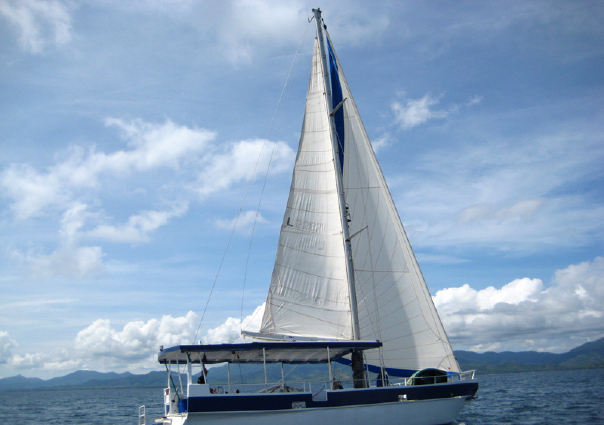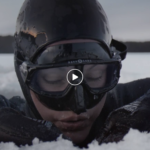
Sailing Basics!

Sailing Basics!
Sailing employs the wind-acting on sails, wingsails or kites to propel a craft on the
surface of the water (sailing ship, sailboat, windsurfer, or kitesurfer), on ice (iceboat) or on land (land yacht) over a chosen course, which is often part of a larger plan of navigation.
A course defined with respect to the true wind direction is called a point of sail.
Conventional sailing craft cannot derive power from sails on a point of sail that is too close into the wind. On a given point of sail, the sailor adjusts the alignment of each sail with
respect to the apparent wind direction (as perceived on the craft) to mobilize the power of the wind. The forces transmitted via the sails are resisted by forces from the hull, keel, and rudder of a sailing craft, by forces from skate runners of an iceboat, or by forces from wheels of a land sailing craft to allow steering the course.
In the 21st century, most sailing represents a form of recreation or sport. Recreational sailing or yachting can be divided into racing and cruising. Cruising can include extended offshore and ocean-crossing trips, coastal sailing within sight of land, and day sailing.
Until the mid of the 19th century, sailing ships were the primary means for marine commerce, this period is known as ‘The Age of Sail’.
Throughout history sailing has been instrumental in the development of civilization,affording humanity greater mobility than travel over land, whether for trade transport or warfare and the capacity for fishing. The earliest representation of a ship under sail appears on a painted disc found in Kuwait dating between 5000 and 5500 BCE. Polynesian ocean-farers traveled vast distances of open ocean in outrigger canoes using navigation methods such as stick and charts.Advances in sailing technology from the Middle Ages onward enabled Arab, Chinese, Indian and European explorers to make longer voyages into regions with extreme weather and climatic conditions.There were improvements in sails, masts and rigging; improvements in marine navigation,including the cross tree and charts of both the sea and constellations, which allowed more certainty in sea travel. From the 15th Century onwards, European ships went further North, stayed longer on the Grand Banks and in the Gulf of St. Lawrence, and eventually began to explore the Pacific North-West and the Western Arctic. Sailing has contributed to many great explorations in the world.
The Egyptians used a bi-pod mast to support a sail that allowed a reed craft to travel upriver with a following wind, as late as 3,500 BCE Such sails evolved into the square-sail rig that persisted up to the 19th Century. Such rigs generally could not sail much closer than 80° to the wind. Fore-and-aft rigs appear to have evolved in South-east Asia allowing for rigs that could sail as close as 60-75° off the wind.
A traditional modern yacht is technically called a “Bermuda sloop” (sometimes a “Bermudan sloop”). A sloop is any boat that has a single mast and usually a single headsail (generally a jib) in addition to the mainsail (Bermuda rig but c.f. Friendship sloop). A cutter (boat) also has a single mast, set further aft than a sloop and more than one headsail. Additionally, Bermuda sloops only have a single sail behind the mast. Other types of sloops are gaff-rigged sloops and lateen sloops. Gaff-rigged sloops have quadrilateral mainsails with a gaff (a small boom) at their upper edge (the “head” of the sail). Gaff-rigged vessels may also have another sail, called a topsail, above the gaff. Lateen sloops have triangular sails with the upper edge attached to a gaff, and the lower edge attached to the boom, and the boom and gaff are attached to each other via some type of a hinge. It is also possible for a sloop to be square rigged (having large square sails like a Napoleonic Wars-era ship of the line). Note that a “sloop of war”, in the naval sense, may well have more than one mast, and is not properly a sloop by the modern meaning.
If a boat has two masts, it may be a schooner, a ketch, or a yawl, if it is rigged fore-and-aft on all masts. A schooner may have any number of masts provided the second from the front is the tallest (called the “main mast”). In both a ketch and a yawl, the foremost mast is tallest, and thus the main mast, while the rear mast is shorter, and called the mizzen mast. The
difference between a ketch and a yawl is that in a ketch, the mizzen mast is forward of the rudderpost (the axis of rotation for the rudder), while a yawl has its mizzen mast behind the rudderpost. In modern parlance, a brigantine is a vessel whose forward mast is rigged with square sails, while her after mast is rigged fore-and-aft. A brig is a vessel with two masts both rigged square.
As one gets into three or more masts the number of combinations rises and one gets barques, barquentines, and full rigged ships.
A spinnaker is a large, full sail that is only used when sailing off wind either reaching or downwind, to catch the maximum amount of wind.
Mainsail – is a sail located behind the main mast of a sailing vessel.
On a square rigged vessel, it is the lowest and largest sail on the main mast.
On a fore-and-aft rigged vessel, it is the lowest and largest and often the only sail rigged aft of the main mast, and is controlled along its foot by a spar known as the boom. A sail rigged in this position without a boom is generally called a trysail, and is used in extremely heavy
weather.
Trditional fore-and-aft rigs used a four-sided gaff rigged mainsail, sometimes setting a gaff topsail above it.
Staysail – is a fore-and-aft rigged sail whose
luff can be affixed to a stay running forward
(and most often but not always downwards)
from a mast to the deck, the bowsprit, or to
another mast.
Spinnaker – is a sail designed specifically for sailing off the wind from a reaching course to a downwind, i.e. with the wind 90°–180° off bow. The spinnaker fills with wind and balloons out in front of the boat when it is deployed, called flying. It is constructed of lightweight fabric, usually nylon, and is often brightly coloured. It may be optimised for a particular range of wind angles, as either a reaching or a running spinnaker, by the shaping of the panels and seams. Some types of spinnaker can be carried by the side of the boat, but still in front of the mast. This is called “flying a shy spinnaker”, and is used for reaching.
The spinnaker is often called a kite, or a chute (as in cruising chute) because it somewhat resembles a parachute in both construction and appearance. This should not be confused with the spinnaker chute which is a hull fitting sometimes used for launching and recovering the spinnaker. A purported etymology has the first boat to carry this sail being a Cowes yacht named Sphinx, from which “Sphinx’s Acre” and eventually “Spinnaker”.
Hull – is the watertight body of a ship or boat. Above the hull is the superstructure and/or deckhouse, where present. The line where the hull meets the water surface is called the
waterline.
The structure of the hull varies depending on the vessel type. In a typical modern steel ship, the structure consists of watertight and non-tight decks, major transverse and watertight (and also sometimes non-tight or longitudinal) members called bulkheads, intermediate members such as girders, stringers and webs, and minor members called ordinary transverse frames, frames, are longitudinal, depending on the structural arrangement. The uppermost continuous deck may be called the “upper deck”, “weather deck”, “spar deck”, “main deck”, or simply the “deck”. The specific name given depends on the context-the type of ship or boat, the arrangement, or even where it sails. Not all hulls are decked (for instance a Dinghy).
In a typical wooden sailboat, the hull is constructed of wooden planking, supported by transverse frames (often referred to as ribs) and bulkheads, which are further tied together by longitudinal stringers or ceiling. Often but not always there is a centerline longitudinal member called a keel. In fiberglass or composite hulls, the structure may resemble wooden or steel vessels to some extent, or be of a monocoque arrangement. In many cases, composite hulls are built by sandwiching thin fiber re-inforced skins over a lightweight but reasonably rigid core of foam, balsa wood, impregnated paper honeycomb or other
materials.
Keel – On boats and ships, the keel is one of two parts: a structural element that sometimes resembles a fin and protrudes below a boat along the central line,or a hydrodynamic element. These parts overlap. As the laying down of the keel is the initial step in the construction of a ship, in British and American shipbuilding traditions the construction is dated from this event. Only the ship’s launching is considered more significant in its creation.
The word can also be used as a synecdoche to refer to a complete boat, such as a keelboat.
Rudder – is a primary control surface used to steer a ship, boat, submarine, hovercraft, aircraft, or other conveyance that moves through a fluid medium (generally air or water). On an aircraft, the rudder is used primarily to counter adverse yaw and p-factor and snot the primary control used to turn the airplane. A rudder operates by redirecting the fluid past the hull (watercraft) or fuselage, thus imparting a turning or yawing motion to the craft. In basic form, a rudder is a flat plane or sheet of material attached with hinges to the craft’s stern, tail, or after end. Often rudders are shaped so as to minimize hydrodynamic or aerodynamic drag. On simple watercraft, a tiller-essentially, a stick or pole acting as a lever arm-may be attached to the top of the rudder to allow it to be turned by a helmsman. In larger vessels, cables, pushrods, or hydraulics may be used to link rudders to steering wheels. In typical aircraft, the rudder is operated by pedals via mechanical linkages or hydraulics.
Skeg, (skegg or skag) – is a sternward extension of the keel of boats and ships which have a rudder mounted on the centre line.The term also applies to the lowest point on an outboard motor or the outdrive of an inboard/outboard. In more recent years, the name has been used for a fin on a surfboard which improves directional stability and to a movable fin on a kayak which
adjusts the boat’s centre of lateral resistance (it moves the center of resistance relative to the center of effort). The term is also often used for the fin on water skis in the U.S. and for the tail bumpers of aircraft in the US Navy.
Spar – The mast of a sailing vessel is a tall spar, or arrangement of spars, erected more or less vertically on the centre-line of a ship or boat. Its purposes include carrying sail, spars, and derricks, and giving necessary height to a navigation light, look-out position, signal yard, control position, radio aerial or a signal lamp.Large ships have several masts, with the size and configuration depending on the style of ship. Nearly all sailing masts are guyed.
Until the mid-19th Century all vessels’ masts were made of wood formed from a single or several pieces of timber which typically consisted of the trunk of a conifer tree. From the 16th Century, vessels were often built of a size requiring masts taller and thicker than could be made from single tree trunks. On these larger vessels, to achieve the required height, the masts were built from up to four sections (also called masts), known in order of rising height above the decks as the lower,
top, topgallant and royal masts. Giving the lower sections sufficient thickness necessitated building them up from separate pieces of wood. Such a section was known as a made mast, as opposed to sections formed from single pieces of timber, which were known as pole masts.
Spreader is a spar on a sailboat used to deflect the shrouds to allow them to better support the mast. Often, there are multiples, called spreaders. The spreader or spreaders serve much the same purpose as the crosstrees and tops in a traditional sailing vessel.
Spreader design and tuning can be quite complex. The spreaders may be fixed (rigid) or swinging (pivoted at the mast). The purpose of the spreaders is to control, by either limiting, or inducing, bend into the spar so that when the windward shroud is loaded the mast achieves the desired bend characteristics. The spreaders may be designed to be angled in a way that either forces bend in to the spar or reduces bend, depending on the desired results.
Shrouds – On a sailboat, the shrouds are pieces of standing rigging which hold the mast up from side to side. There is frequently more than one shroud on each side of the boat.
Usually a shroud will connect at the top of the mast, and additional shrouds might connect partway down the mast, depending on the design of the boat. Shrouds terminate at their bottom ends at the chain plates, which are tied into the hull. They are sometimes held outboard by channels, a ledge that keeps the shrouds clear of the gunwales.
Shrouds are attached symmetrically on both the port and starboard sides. For those shrouds which attach high up the mast, a structure projecting from the mast must be used to increase the angle of the shroud at the attachment point, providing more support to the mast. On most sailing boats, such structures are called spreaders, and the shrouds they hold continue down to the deck. On large sailing ships, however, particularly square-riggers, the shrouds end at the projections (called tops or crosstrees) and their loads are carried into the mast slightly further down by futtock shrouds.
Sheet – In sailing, a sheet is a line (rope, cable or chain) used to control the movable corner(s) (clews) of a sail.
The length of chain running diagonally up and right from the bottom-left of this picture to the upper of the two yards is the fore-lower-topsail sheet. Some of the lines on Prince William‘s larger sails are made of chain to handle the heavy loads while remaining flexible enough to pass through the various blocks on their route to the deck.
Boom – In sailing, a boom is a spar (pole), along the foot of a fore and aft rigged sail, that greatly improves control of the angle and shape of the sail. The primary action of the boom is to keep the foot flatter when the sail angle is away from the centerline of the boat. The boom also serves as an attachment point for more sophisticated control lines. Because of the improved sail control it is rare to find a non-headsail without a boom, but lateen sails, for instance, are loose-footed. In some modern applications, the sail is rolled up into the boom for storage or reefing (shortening sail)
Spinnaker pole – is a spar used in sailboats (both dinghies and yachts) to help support and
control a variety of headsails, particularly the spinnaker. However, it is also used witho
ther sails, such as genoas and jibs, when sailing downwind with no spinnaker hoisted. (Since the load on a spinnaker pole is very light on this point of sailing, sometimes a special light spinnaker pole called a whisker pole is used in these circumstances.)
The spinnaker pole is rigged to run from the base of the mast, where there is a special
fitting for attaching one end of the pole, out to windward over the side of the boat. There, one of the control lines of whichever sail it is to be used with is run through a fitting on the other end of the spinnaker pole. This allows for more precise control of the corner of the sail to which the line is attached.
For a spinnaker, the line attached to the pole is the guy, or brace, and the corner is the tack. For other headsails, such as a jib, the line would be the sheet, attached to the clew.
A special line, the topping lift, runs from the middle of the spinnaker pole up to a block on the mast, and is used to support the weight of the spinnaker pole. Another line referred to as the downhaul or foreguy runs down so that the height of the pole is under positive control at all times.
Backstay – is a piece of standing rigging on a sailing vessel that runs from the mast to
either its transom or rear quarter, counteracting the forestay and jib. It is an important sail trimc
ontrol and has a direct effect on the shape of the mainsail and the headsail. Backstays are generally adjusted by block and tackle, hydraulic adjusters, or lines leading to winches.
Forestay – On a sailing vessel, a forestay, sometimes just called a stay, is a piece of standing rigging which keeps a mast from falling backwards. It is attached either at the very top of the mast, or in fractional rigs between about 1/8 and 1/4 from the top of the mast. The other end of the forestay is attached to the bow of the boat.
Often a sail is attached to the forestay. This sail may be a jib or a genoa. In a cutter rig, the jib or jibs are flown from stays in front of the forestay, perhaps going from the masthead to a bowsprit. The sail on the forestay is then referred to as the staysail or stays’.
A forestay might be made from stainless steel wire on a modern yacht, solid stainless steel rod, carbon rod, or ultra high molecular weight polyethylene (such as Spectra or Dyneema) on a high-performance racing boat, and galvanised wire or natural fibers on an older cutter or square-rigged ship.
Boom Vang(US) – or kicking strap (UK) is a line or piston system on a sailboat used to exert downward force on the boom and thus control the shape of the sail. The Collins English Dictionary defines it as “A rope or tackle extended from the boom of a fore-and-aft mainsail to a deck fitting of a vessel when running, in order to keep the boom from riding up”.
The vang typically runs from the base of the mast to a point about a third of the way out the boom. Due to the great force necessary to change the height of the boom while a boat is under sail, a line-based boom vang usually includes some sort of a pulley system. Hydraulic piston vangs are used on larger sailboats and controlled by manual or electric hydraulic pumps.
The term kicking strap is normally shortened to “kicker” whilst sailing, e.g. “Hard on the kicker when we get to the leeward mark”.
On some sailing boats, such as the 49er, rather than a set of lines pulling the boom downwards, a rigid member is used to push the boom down. By controlling leech tension, the boom vang is one of the three methods of controlling sail twist. On small sailboats and some cruising sailboats a vang may be omitted. If a vang is not installed, then the sheet has to try to
control both horizontal and vertical angles of the boom. When the boom is near the centerline, the sheet is nearly vertical, and can exert downward force on the boom. As the sheet is loosened to increase the horizontal angle of the boom and sail, the sheet becomes horizontal and exerts less downward force. A vang works with the sheet to apply the downward force on the boom at all horizontal angles, allowing the sheet to be used to control the horizontal angle of the boom effectively.
While under sail, the opposite force to the vang is supplied by the sail itself. When the sail is furled, a topping lift supplies the upward force on the boom. Some line vang systems
incorporate a piston to provide the topping lift force and to damp oscillations. Hydraulic vangs can inherently act in the topping lift role.
A gnav (the word vang spelt backwards) is an inverted vang. It is a rigid strut that extends obliquely upward from the boom to the mast, exerting a force that pushes down on the boom. As the fixing point of the gnav on the boom is hauled inwards towards the mast, the downward force on the boom increases. A gnav offers more uncluttered space beneath the boom when compared to a vang.
telescopic tube to support the boom and a pulley system to tighten the vang as
shown in this picture.












